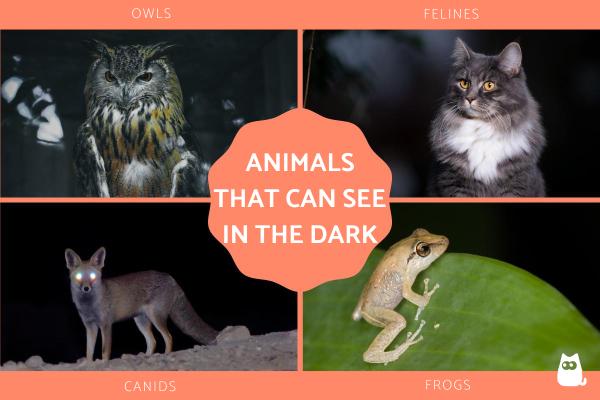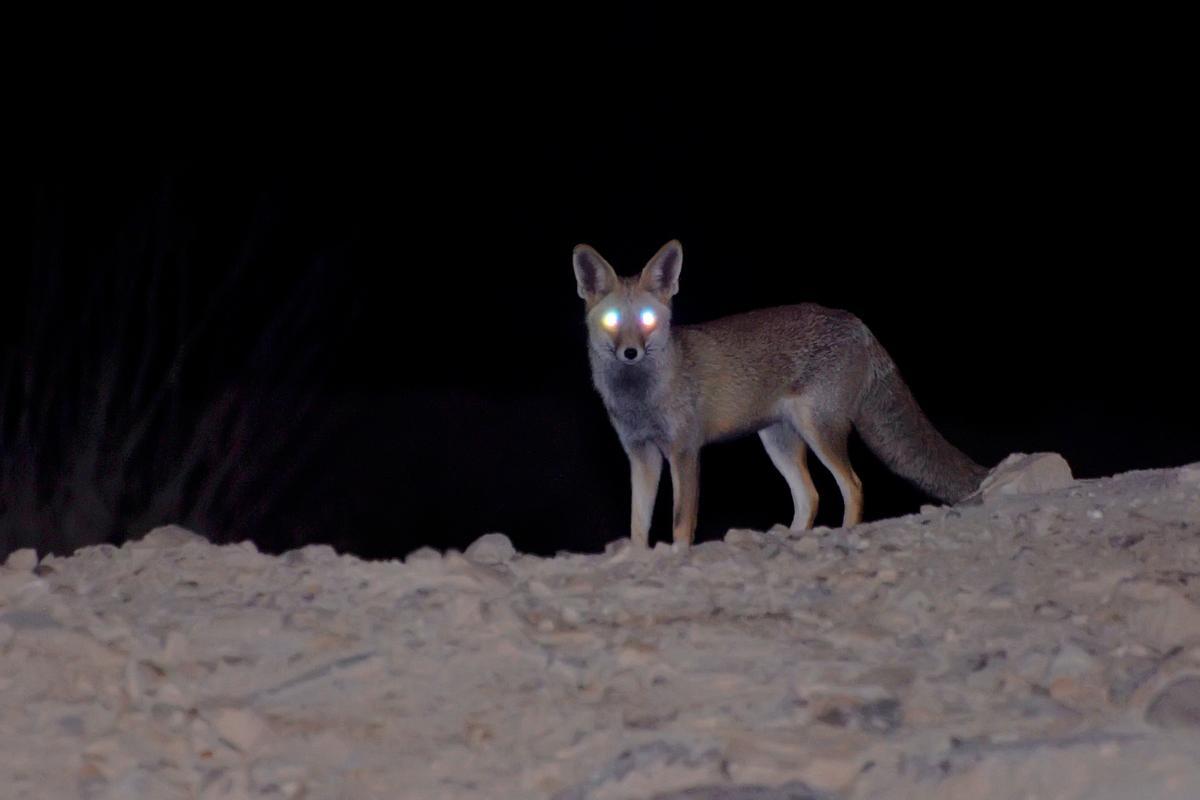Animals That Can See in the Dark


The animals that can see in the dark are those which take what little light is present in their environment and enhance it for better night vision. They do this thanks to specially adapted eyes which have evolved morphologically to reflect light into receptor cells. Seeing in the dark allows animals which thrive best with nocturnal or crepuscular behaviors. No animal can see in total darkness, i.e. the complete absence of light. If an animal lives in an environment with no light, they can use other senses to navigate. Generally speaking vertebrate animals have organs which can allow for better vision, but there are invertebrates which can see in the dark also.
At AnimalWised, we discover what animals can see in the dark. This is a list of the animals with the best night vision where we explain how their physiological adaptations allow them to see better in low-light environments.
Why can some animals see in the dark?
As we have explained, no animal can see in total darkness. Most animals will have some ability to see when there isn't much light. Those that can't see at all might evolve to become truly blind, as is the case with the blind mole-rat (subfamily Spalacinae). The animals that can best see in the dark have adapted ways to enhance what little light there is to improve their night vision.
These animals have eyes that are anatomically and physiologically adapted to create images of what they see using very little light. Humans do not have this ability since we need a greater amount of light to allow our brain to receive images.
Night vision in nature is essential for many animals. They are dependent on it for certain activities such as hunting, evading predation, reproduction or even travel in environments which have very little natural light. Some of these animals are rarely active in periods where there is more light, but others can have good night vision and also carry out behaviors adequately during the day.
How do animals see in the dark?
Animal detect light thanks to specialized cells in their eyes. These cells act as photoreceptors transmit the image to the brain and essentially create the sense of vision. While they vary according to many factors, these cells can be divided into two main categories:
- Cones: are mainly used during the day and are activated when light photons hit them. When this happens, signals are sent to the brain so that it is processed and forms the observed image. In this way, the cones allow the formation of good color vision due to their daytime activation. In the absence of light, they do not respond in the same way. This is what happens in human vision.
- Rods: unlike cones, rods act as photoreceptors in the dark since they are more sensitive to low lighting. With them animals cannot differentiate colors. This is seen in dogs which can only see certain colors thanks to the limited types of rod cell in their eyes.
Animals are able to see in the dark due to the adaptations of their eyes, their physical makeup and the relationship between these ocular structures and the brain. These specialized photoreceptor cells can capture what few rays of light are in an environment and create bright images with them. They also eliminate light signals which might interfere with properly capturing the image.
In general, the vision of vertebrates and invertebrates presents some differences:
- Vertebrates: all vertebrate animals have the same basic ocular structure. This includes a pupil that regulates the amount of light that enters the eye by contraction and dilated. They also have a lens that helps focus on the retina, which is the part most sensitive to light. A set of optical nerves are responsible for transmitting information to the brain.
- Invertebrates: these animals can have simple eyes called ocelli or more complex compound eyes. Although ocelli are less complex, they allow animals to have vision by capturing shapes and movements. The more developed compound eyes offer broader vision. Some invertebrates have developed excellent vision comparable to that of vertebrates.
Many animals can see in the dark because they have developed specific characteristics. These include as large eyes which are sometimes tubular. Their pupils adapt well to the size of the eye. As we have mentioned, physiologically they capture the low light thanks to the fact that they have more rod than cone cells. This allow them to form better images.
Another structure that helps many animals have good night vision is known as tapetum lucidum. This is a tissue located behind the retina and that works like a mirror by reflecting the little light that enters the eye back to the retina. Although very useful, it is a relatively simple structure.
Animals which have a tapetum lucidum include the domestic feline. They are able to see better in low-light conditions, something which is important for their crepuscular behavior. As an example, we show an image of the anatomy of the cat's eye below to more clearly observe the location of this tissue.
Why do animal eyes glow in the dark?
It is common for us to see the eyes of some animals glowing in the dark. This can be seen especially if they are exposed to a light source such as a flashlight, or car headlights. This is due to the presence of the tapetum lucidum. This membrane not only reflects the light back to the retina, but when a bright light is shone on it, it reflects it back out of the pupil. The color can differ due to the color of the pigments in the tapetum lucidum.
Discover more with our article on why a cat's eyes glow in the dark.

Animals that can see best in the dark
Now that we know why there are animals that have better night vision than others and how this is possible, we can see some of the best examples of animals that can see in the dark below:
- Owls: are mainly nocturnal animals, being excellent hunters due to their hearing, silent flight and excellent night vision. They have very large eyes in proportion to their skull, which have a tubular shape. They cannot move their eyes, so they move their head in all directions. Discover more about owls with our article on types of nocturnal birds of prey.
- Felines: also have very good night vision which makes them excellent hunters. They have large eyes with binocular vision. They are from the group of animals with a tapetum lucidum and a high number of rods.
- Canids: among animals with the best night vision we can also mention canids, such as foxes, wolves and dogs. Dog eyes also glow in the dark thanks to the presence of the tapetum lucidum.
- Insects: invertebrates such as insects have different eyes than vertebrates, but there are species very well adapted to see at night. Among the examples we have a type of sweat bee identified as Megalopta genalis. This bee feeds at night because it has visual adaptations that make it more than twenty times sensitive to low lighting. We can also mention moths from the order Lepidoptera, many of which are nocturnal and even capable of distinguishing yellow from blue. Some beetles also have good night vision.
- Frogs: frogs have proven to be able to distinguish the presence of low light that even humans cannot detect. They distinguish between the color blue and green, having a preference for the latter. This is apparently due to the fact that its wavelength is long, like that of the light from the stars by which they can use to guide themselves during the night.
- Fish: have eyes similar to other vertebrates, with cones and rods, but their lens is more spherical. Many can distinguish colors and polarized and even ultraviolet light. Because various species must live at depths where light is scarce, they are adapted to see in the dark thanks to the presence of the tapetum and specialized pigments. Some of these animals are even known to glow in the dark without the presence of light.
If you know any other animals that can see in the dark, feel free to share your favorites in the comments below.

If you want to read similar articles to Animals That Can See in the Dark, we recommend you visit our Facts about the animal kingdom category.
- Animal Diversity Web (2013). Retrieved from: https://animaldiversity.org/
- Dance, A. (2019). Animals Use Brain Tricks to See in the Dark. Retrieved from: https://www.scientificamerican.com/article/animals-use-brain-tricks-to-see-in-the-dark/
- Shen, L. (2012). Night Vision: How Animals See in the Dark. Retrieved from: https://northernwoodlands.org/outside_story/article/night-vision-how-animals-see







